Evan, Amael


Evan, Amael

Exquisite Build
Rules:
Artist’s Statement:
This piece was inspired heavily by the “Exquisite Corpse” piece, as well as games like Jackbox and Cards Against Humanity. During the appropriation show and tell, someone jokingly asked if Lego was a form of appropriation. Right when I heard that, I immediately latched onto the idea of using Legos as the appropriated material, but then came the question of what the game would actually be. In the past, Lego had a wave of Lego board games, and I wondered if I should do something akin to that, like a classic board game recreated in Lego, or something along those lines, however nothing really stuck for me. When I thought about my favorite games to play nowadays, I love games like Cards Against Humanity or some of the Jackbox games, where the players are all given one prompt, and each gives a unique response to be judged by the other players or another player. In particular, I really latched onto the idea of one player being a judge, and the rest building something to impress them. In addition, the Jackbox game, Civic Doodle (itself a sort of appropriation of the exquisite corpse formula) was a source of inspiration, as two players were pitted against each other to draw a subject, and then judged. The winner’s piece would then be amended by another two players, and that amendment would be judged, and so on and so on. My game sort of acts as a three dimensional version of Civic Doodle, as the players build upon the foundation set by the last round’s winner. While designing my game, I tried to draw from general concepts we’ve talked about in class, such as the transformation of an object’s purpose, collaborative creation, and creativity in the artistic method. In this game, players are forced to collaborate with each other as they build off of each other’s previous designs. In addition their piece selection and building time is limited, thus transforming the normal Lego building process, in which you are provided all the pieces you need and unlimited time to build the set you purchased into a competitive scramble to collect random pieces in order to build whatever you can in the given time. The Lego pieces act as the appropriated material despite being used as they usually are, as building blocks to make a model of something. Despite the Lego company encouraging creativity and collaboration, most Lego sets nowadays are designed to be built by one person following a given set of instructions. This game, though, uses the pieces to fulfill these values held closely by the Lego company, by encouraging the players to build more uniquely in order to win and contribute to the overall creation.
Documentation
For this shortened round, the card pulled listed:
Object: Wall
Topics: Wall
The first topic for the build was a wall with holes.

Photo 1: Here we see the two players in the midst of their first collection phase, grasping at whatever pieces they can get before the time runs out.
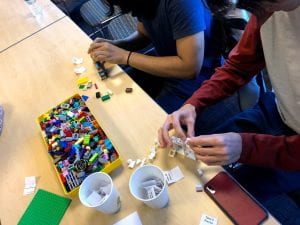
Photo 2: In the midst of the second building phase, the players designs begin to take hold as they put together what they can with the pieces they’ve acquired.
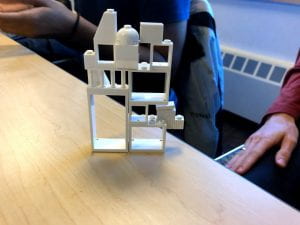
Photo 3: The first build produced, an artistic wall packed with a variety of holes of different sizes and shapes. A design completely white due to the players wishes. This wall ultimately wins the first phase.
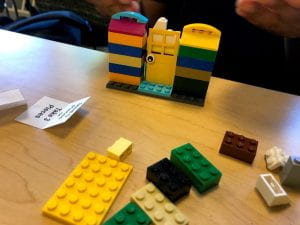
Photo 4: The other first build produced. A worth opponent, filled with a variety of colors and a non-functioning door piece. The player used the door as a barrier, without its traditional hinges, and with an eyeball as the door handle. Is this an appropriation piece in itself? Makes one wonder.
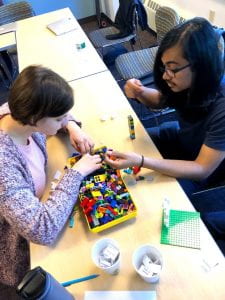
Photo 5: The second stage of the building of the wall. This time, the topic was to continue the trend of the winning wall, and to build a white wall. Here we see the two players in this second stage in the midst of their collection phase, searching for pieces.
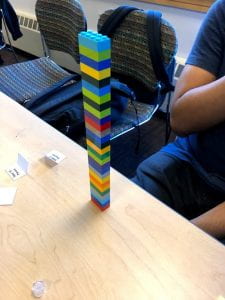
Photo 6: The winning build produced in this second stage. The player decided to stack bricks of varying color but same size and shape upon each other. He argued that since all colors of light together make white, that’s what is happening here. Truly a compelling argument.
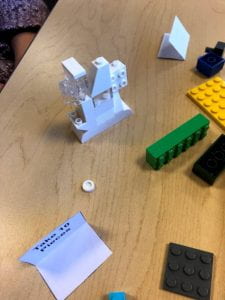
Photo 7: The other wall built in the second stage. Despite its small size, the wall consists entirely of white or clear pieces, to uphold the white aesthetic established by the first build.
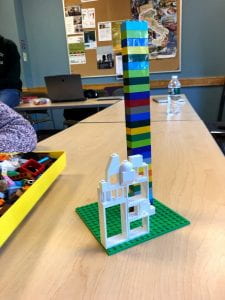
Photo 8: The two walls, placed together on the baseplate to create the final product. An artistic wall with an interesting juxtaposition between their colors.
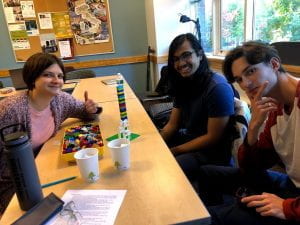
Photo 9: Fun for friends and family!
I originally intended for this game to be a single player experience, but after playtesting with an improvised multiplayer mode where each player would take a turn drawing, I realized that the multiplayer was the real source of fun for the game. There was a lot of emergent behavior I would never have seen in the single player game. The players began to play cooperatively and began helping each other out with their drawings. Some began to purposefully draw in a certain way as to help the other player with their next drawing. The game turned into this strange dialogue between the players as they were both helping each other turn the same thing into two different things. There were some other emergent behaviors that I didn’t expect for individual players. When I played the game, I drew very minimally to make the next drawing easier. Seeing others play, they added a lot more detail that I would’ve added. People became very attached to their drawings in a way that I didn’t necessarily intend. People overall seemed to want more control over their drawing, so I added the ability to move the camera and zoom in and out as well as undo drawings.
For my appropriation game, the player is given a prompt to draw, which must be drawn by appropriating the previous player’s drawing. After the drawing is complete a new prompt is given to the next player. My original idea with this game was to somehow have the game mechanic be appropriation itself. In my pitch, the game mechanic was for the player to be able to explore their own creations that have been appropriated by the computer. I was inspired by a lot of the more theatrical Dada pieces, especially the earlier Zurich movement where the participation of the audience was a key part of the performance. In this game the player is key in the performance of appropriation. After making the game multiplayer, the form of appropriation transformed so that while the two players had the same object that they were appropriating, they were instructed to appropriate in two seemingly conflicting ways. With this game I saw the use of appropriation as a way to resolve these conflicts. When the players would need to turn a dog into a tree through only additional pencil strokes, there is an immediate conflict that arises. The message I wanted to send through this piece was that only through the act of appropriation by the player do they progress. Another interesting part of my game is scale. I was inspired by the use of scale as a tool for transformation such as the giant joystick or tiny hammer. I forced the player’s drawings to zoom out over time rather than just have them move along the screen.

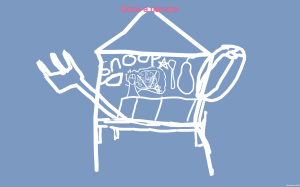
The final title of my game is “Star Corpse”. I appropriated some of the mechanics of Exquisite Corpse, such as each player contributes something to a final piece of art, but I wanted to use collage instead of drawing. I was also interested in collage based on the DADA collages. Originally I bought two magazines: Star and Downtown Abbey. I gave each of the four players a part of the body: head, torso (without arms), arms, and legs. I playtested with 3 different prompts, using both magazines and a piece of graph paper for the base. 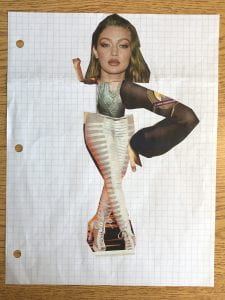
The prompt for this piece was “The Perfect Female Form”
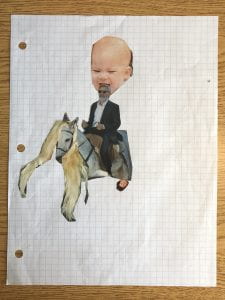
The prompt for this piece was “An Abomination” with no body part suggestions.
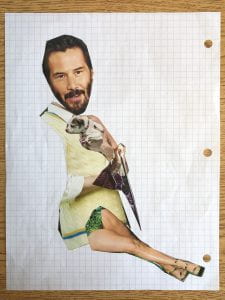
This prompt was “The Ideal Male Form”
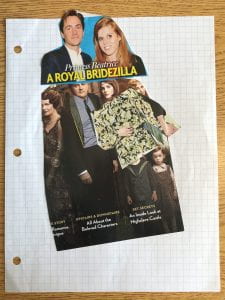
And this prompt was another “An Abomination” prompt with no suggestions for body parts.
What I found from this playtesting was that the abomination prompts seemed 50-50 on outcomes that matched the aesthetic I was trying to evoke. After talking about it with Celia and my peers, some changes that I decided to make are as follows:
Use stockier paper, always give a body part suggestion, and make the players name their piece when finished. Additionally I decided to broaden my prompts using found words within the Star magazine. I also decided not to use the Downtown Abbey magazine because I found that players tended not to use it when given the choice, and that the material within seemed overall less inspiring. I also made small changes to how the game was played, one prompt card for the group, with each person getting a body part, as opposed to each person getting both.
Here’s what we got:
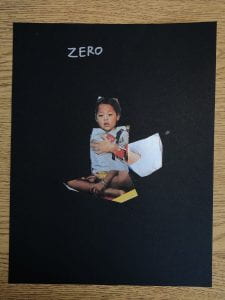
The prompt for this piece was “CHILD.” They decided to name it Zero.

The prompt for this piece was “PAPARAZZI.” They named it big Hamds McGee, a play on big hands combined with hamburger something- it was a reference I didn’t quite get.
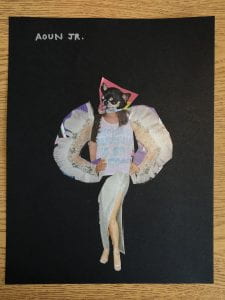
This piece’s prompt was “ACTION STAR.” They named it Aoun Jr.
Overall I was happy with the improvements made from the first playtest to my final playtests. I found that the players tended to name the character they created, not necessarily the “piece,” as I thought they would. The paper change really brought up the production quality of the final piece. I also felt that limiting the source to only the Star magazine also helped solidify somewhat of a theme. Other prompts that I created but weren’t able to playtest were: “Beautiful, stepson, and legend.” Looking back though, if I were to spend more time playtesting, I would try putting the collage on grid paper, and then putting the grid paper on the stockier black paper with a black outline. I do sort-of like the gritty, rugged look that came with the lighter grid paper.
Something that caught my interest during class, was whenever someone took a very simple game and created an entirely new experience by changing one mechanic of the game. Some examples that come to mind are the giant joystick by Mary Flanagan and the Octopad by Patrick Lemieux, an 8-person game controllers where each person can only push one button. I wanted to do something similar with the very simple game of Rock Paper and Scissors. I wanted to see this game played with more collaboration and chaos. So, I decided to merge the game of Rock Paper and Scissors with the game Mountains of Madness.
Mountains of Madness is a boardgame I discovered about a month ago. The aim of the game is to have a team of five players reach the top of the mountain alive with as much treasure as they can. To do so, the players must work together against a bunch of mini challenges. In order to beat these challenges, communication is the most important thing. If the team ever fails a challenge, one of the players gets a madness card. Madness cards impair that member’s ability to communicate in some way, which make the game progressively harder the more and more you fail challenges. Each player can have up to three madness cards each, which make the game very exciting, crazy, and chaotic.
My combination of Rock Paper and Scissors and Mountains of Madness, called Mad Rock Paper Scissors, is best played with 6, 8, 10, or 12 players. The group of players is split into two teams. In order to win each member of one team must decide on an action to use on the other team, however, they must all perform this one action in sync in order to get the point. For example, if team 1 all perform “rock” and team 2 all person “scissors”, team 1 wins. But if 2 members of team 1 perform “rock” and the other 2 members of team 1 person “scissors”, that team automatically loses.
The game consists of at least three rounds. Before each round, each team has 45 seconds to discuss what action they will perform. During the first round, neither team has a madness card. During the second round, each team has one madness card that each team member shares. During the third round and onward, each team member will have their own madness card. The distribution of the madness card is random before each new round. Like Rock Paper and Scissors, it runs on a “best out of three, best out of five” method where the teams decide how long they want to play.
I do not own the game Mountains of Madness, so I was unable to use the real madness cards. Instead I made my own and formatted them to fit the game of Rock Paper and Scissors better. There are blue and green cards. Blue cards are normal madness cards. Green cards are more restricting. Green cards restrict what action a single player can perform. For example, a green card can tell the player that they can only do rock. This player would have to convince their team to person this single action. Each team can only have as most one green card, because too many green cards can lead to impossible outcomes. If two team members both have green cards and one member can only do rock while the other can only do scissors, then the entire team is doomed to fail.
When I presented this game in front of the class, it is interesting to note groups would perform fake hand gestures during the discussion period in order to deceive the other group. This interaction between players was a fun addition I didn’t anticipate.
Examples of Blue Cards:
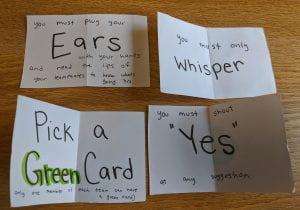
Examples of Green Cards:
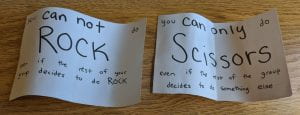

For Artwork #2 I decided to appropriate multiple different card games into one gacha card game. For those who do not know what a “Gacha” game is, here is a brief explanation and history. A Gacha game usually take form of mobile games. The core game mechanic usually having players using in-game currency to “gamble” for playable character base on luck. Because of this luck based system players can get duplicates and have grind for more in-game currency to draw the character they want. This is similar to loot boxes, however loot boxes usually give skins or items that is not essential to the core gameplay. What gacha differs from loot boxes is that it is the core mechanic and attraction. Many popular gacha game came from Japan as well as the term “Gacha”. The origin of this name came from gachapon machines that could be found all over urban Japan. Gachapon usually requires around 100 to 200 yen to draw a random accessory. The first gacha game is “Dragon Collection” on a Japanese social platform called GREE in 2010. Here’s some popular gacha games: Kantai collection, Girls frontline, Azure lane, Fate grand order, Onmyoji, Fire emblem heroes, Pokémon master and even Hearthstone count as a gacha.
During my planning phase I thought about what object that I appropriate and I thought of the Pokémon Cards that I had at my home. Which lead me to combining multiple different card games into a single card game. You can say this combination of multiple items are inspired by Kurt Schwitters. This use of random cards is like Schwitters’ use of random found objects in his collages. What inspired the gacha part is because of the gacha game that I am currently playing and the realization that Hearthstone is essentially a gacha game. The reason that I chose Pokémon, poker and Uno cards is because those are the most accessible cards to me. Pokémon cards fit perfectly as the central battling monster cards. Uno’s special cards provided interesting mechanic to the game. And the basicness of poker cards allowed it to be easily appropriated. During the development phase I have to think of the varies rule that card games have. Thanks to the already existing rule that came with the cards I just have to simplify it and adapt it into my game. Now for the gacha part, since all gacha game are virtual I have to think of a way to bring it to the physical world. I came up with the idea of assigning each card with a dice combination. In most gacha game there is a tier list where high tier characters have the lowest chance of getting. And as a gacha parody I decided to make the top tier Pokémon to be overpowered and have the lowest chance of getting. During the testing phase with my brother he suggested a extension to one of the mechanic: defending, giving it more purpose to take this action. After testing with him, I realized that this isn’t just appropriation of cards but also mechanic. The game has the mechanic of Pokémon, Yugioh, Uno and gacha games.
The cards
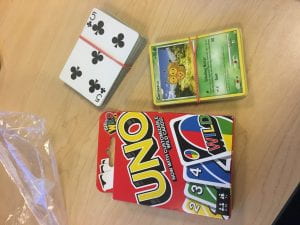
When it’s finally the time to test it in class interesting result appeared. The game is a one on one duel with deck that the player gets through rng. The game was played twice with different people both time and both time one of the player gets exceptionally good pulls, both getting the legendary Pokémon. This made it that in both game one player were up against another player that had good luck. However, the result of the 2 games were different. Through the creation process of this game I have one thing in mind and that is unfairness. In a game of luck like gacha game, people with good luck always had the upper hand. To recreate that feeling I made the best card ridiculously overpowered. The first game ended up as I expected, both players played well but the player with the better luck won. However, in the second game the luckier player lost. I concluded that it’s because the other player have the better strategy. And the second game proved to me that with strategy you can win against luck. You could almost saw the second game as an analogy to some real life situation. Some system are made unfair and people with the better luck generally have a easier time. But with a good “strategy” and hard work you can also succeed.
Game Rule and offering chart
The second games player’s deck


In most video games, you play as a hero trying to achieve an objective while defeating some enemies. Take Space Invaders, for example. In the classic arcade game, you play as a pilot ship trying to destroy evil alien aircraft. It’s obvious that you need to defend what’s right and take down what’s wrong. For my project, I wanted to spin that concept around. In my game, Donut Defender, you play as a pizza slice and your goal is to block and deflect any delicious healthy fruits that fall down the screen. By the way, there is a donut at the bottom of the screen and if a fruit touches it, it will replicate. If enough donuts fill up your screen, you lose the game. Now you might be wondering, shouldn’t I have made a game where the objective was to defend fruits and extinguish donuts and pizzas? Well my goal was intentional. I wanted this game to be a subtle reflection on how America values unhealthy foods. According to data from the federal government, breads, sugary drinks, and pizza are among Americans’ top sources of calories. They are also made from seven crops that are greatly subsidized by the federal government (corn, soybeans, wheat, rice, sorghum, milk, meat). This means that junk foods can not only be made in great quantity, but also for a cheap price. The real kicker is that the government gave $170 billion in agricultural subsidiaries between 1995 and 2010 in order to produce these goods (O’Connor 1). If we live in a society that pushes for so many healthy eating initiatives, how come the money is going to the foods that aren’t so healthy?
Now that I’ve explained my game’s hidden agenda, let me go into detail about the game’s mechanics. Though it is currently a computer game, it is intended to be played on mobile devices. You would use your finger to drag the pizza icon and deflect incoming fruits. For each fruit you deflect, you earn 10-30 points. Apples give you 10, pears give you 20, and bananas 30. My original design had it so that every time a donut replicates, the player would earn more points. This gave the player the incentive to spawn some donuts, so that they would earn more points by the end of the game. I’m still unsure if I want this to be the case and further play testing might help me come to a conclusion. There are also coins that randomly fly across the screen every now and then. If the player were to risk moving to a different position and acquire the coins, they will eventually be able to buy different donut skins. I created five skins so far, but if I further develop the game, I could create more. Overall, I wanted this game to be an easygoing experience that also builds your finger reflexes (and maybe make you think about the FDA).
O’Connor, Anahad. “How the Government Supports Your Junk Food Habit.” The New York Times, The New York Times, 19 July 2016, well.blogs.nytimes.com/2016/07/19/how-the-government-supports-your-junk-food-habit/.
At first glance, this object looks like a normal camera lens. It’s the same exact shape, has image stabilization controls, and a distance indicator. However, if you take a closer look, you’ll realize it is actually a cup. There is a bar in Chinatown called The Ghost Walks. If you go there and order a drink called the Paparazzi, you will receive alcohol in this same exact cup. Made to mimic a Canon camera lens, the cup even has “Caniam” printed on it to make reference. It is an interesting take on what can be used to serve drinks.
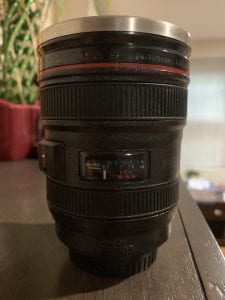
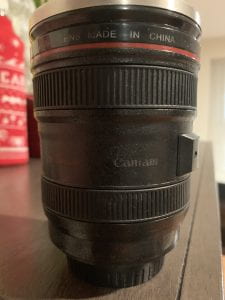
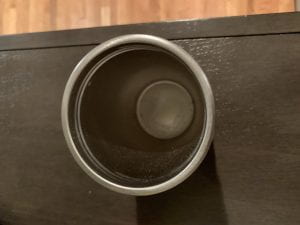
Take multiple Tennis balls and different color paint cans, put the canvas in the middle of the room. Give the artists multiple gloves to be able to pick up and roll the ball across the canvas of different colors. If everyone is alright they may bounce the ball to each other assuming they dont mind getting paint on themselves. The idea originally came around when my friend and personal trainer Kevin Brewerton showed me a video of him doing art with his boxing gloves and punching the canvas with paint on his gloves. I wanted to take a step further and try throwing a baseball or hitting a baseball against the paint however many things can go wrong so quickly with that. Baseballs can deflect and hit someone, not enough space to protect the whole area from getting splashed. I then thought about doing something similar with throwing a tennis ball between two people against the wall but there’s still the potential of breaking the canvas and also dealing with covering up as much ground so we won’t get paint everywhere.
What is needed for the happening:
The results of the Happening: Lack of preparation for the Happening resulted in many changes to the final presentation. Didn’t have a place to prepare for the project nor could I get the tarp that I wanted to stay on the wall. The solution to this was to lay the tarp on the ground and instead bounce the tennis balls covered in paint. The results are shown here:
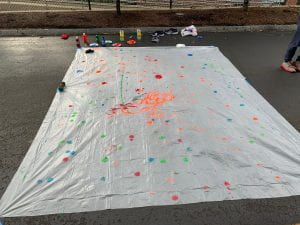


The tennis balls ended up soaking up the paint and not splashing as much as I wished there would be. I had fun with the idea and it would be a lot of fun to potentially take this idea and reserve a room, get a ball that will splash more, and have the liberty of chucking the balls at full force without worrying about damages. I find this can be a fun way to relieve stress by doing physical while also making art through your own physical actions.
To Eat an Apple
Pick an apple from a tree. Choose it carefully to ensure the best quality of taste.
Eat the apple until only the core remains.
Find an empty patch of soil and plant the core of the apple; ensure that there are seeds in the core, not just an empty shell.
Water the soil every day; fertilize it frequently.
Continue nourishing the soil until a sapling sprouts from the ground and grows a couple inches tall.
Find the best books, textbooks, and paintings you can.
Throw them at the sapling.
Leave the sapling in the pile.
Continue to water the earth, even if you can’t see the plant.
(a) Wait until a tree grows upon the books.
Once it reaches a couple of feet tall, take a picture of the tree and frame it.
(b) If the tree does not grow, repeat again, but with an orange.
2019 Fall
Artist’s statement:
“To Eat an Apple” was inspired by a children’s science experiment known as the “Potato Maze” and the scores in Yoko Ono’s Grapefruit. The “Potato Maze” is a science experiment I did in 7th grade, in which a potato is placed at the bottom of a maze-like shoe box with a hole at the top. The goal was for the potato to grow a stem around the obstacles to ultimately poke through the hole and reach sunlight. In addition, I loved the absurd and destructive nature of Yoko Ono’s works, which I wanted to embody in a way that involved college. This semester, as a freshman, I’ve had to adapt to the new college lifestyle. These ideas culminated in “To Eat an Apple”, a score in which you symbolically take the role of a parent, trying to raise an educated child. The apple is heavily tied with the concept of knowledge as the fruit from the tree of knowledge in the “Fall of Man” is often depicted as an apple. In addition, an apple falling on Isaac Newton’s head is the common explanation for the beginning of his research on gravity. The work all together is intended to recreate the feeling of parenthood and entering a child into the college process. In the start, eating the apple is analogous to having sex, as the activity itself satisfies a base desire and (after planting the core) results in new life. Afterwards, the played needs to care for the soil by fertilizing and watering it. Once it sprouts from the ground and becomes large enough, the player throws textbooks and other works at the plant, in order to simulate the schooling process, which can be overwhelming yet ultimately beneficial. As the player continues to water and fertilize the soil laden with books, it becomes difficult to observe the plant itself, so the player must provide distant support. Ultimately the sapling must navigate through the pile of books and grow on its own with the resources given (now transformed into a sort of fertilizer). In the end, if it succeeds, you celebrate with a picture (kind of like at a graduation), but if it doesn’t, you move on and attempt again with a different fruit, an orange, symbolizing that the traditional education route may fail one child, but it may succeed for another (apples to oranges). As discussed in class, the gameplay of this score are intended to convey a meaning, rather than the story itself, as the player unwittingly takes up the role of a parent.
Documentation:
(For some reason WordPress won’t let me upload photos, so I uploaded them to the google album linked below, and you can view them from there)
https://photos.app.goo.gl/84w2poA1bguPA7nM8
Photo 1: The apple I’m using to do the score, picked fresh from the Dining Hall.
Photo 2: Me, biting into the apple, it was really juicy. Not pictured: Me eating the rest of the apple.
Photo 3: Me, holding up the completely finished apple core to show that the deed had been done, I had consumed the apple, leaving behind only the core.
Photo 4: A picture of the seeds contained inside the core of the decimated apple.
Photo 5: The core in a hole in the soil, being prepared to be buried. (I did this somewhere in Fenway in some soft soil).
Photo 6: The core completely buried now, with soil and wood chips pushed over it.
Photo 7: Me, watering the spot in the soil with the apple core.
That was as far as I could go as the plant didn’t grow yet.